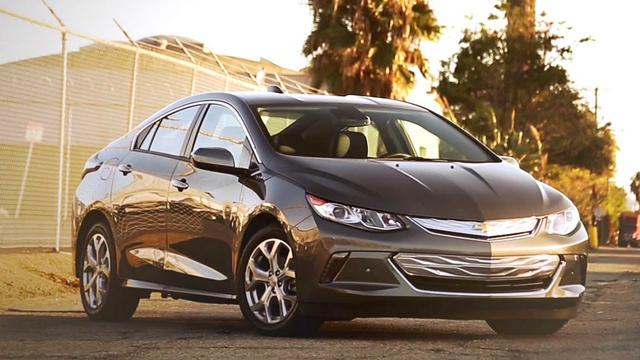The national average for regular gasoline recently dipped to $2.16 per gallon, more than half a buck lower than it was a year ago. That’s great for commuters but trouble for the fuel-sipping 2017 Chevrolet Volt reviewed here. When gas is cheap, new-vehicle shoppers’ thoughts drift toward plus-size SUVs and heavy-duty pickups. The few smart ones who hedge their bets know that a palace coup on the opposite side of the globe could spike pump prices.
Volt Compared and Best EVs and Hybrids2017 Chevrolet Volt vs. 2017 Toyota Prius PrimeBest EVs and Hybrids of 2022Every Plug-In-Hybrid Vehicle for Sale in the U.S.
The Volt’s clean-sheet redesign for 2016 confirms that General Motors is serious about its stake in the efficiency corner of the market in spite of temporarily cheap fuel. Born in 2010 as an “extended-range electric vehicle,” the Volt cleared a path for what we now call plug-in hybrids. The dozen or so plug-ins currently on the market range from the Toyota Prius Prime with an estimated base price of $30,000 to the $141,695 BMW i8.
View PhotosCHRIS DOANE AUTOMOTIVE
The Volt falls closer to the Prius end of the spectrum as a sleek four-door hatchback with a 1.5-liter four-cylinder engine and two AC motor/generators for propulsion. The clever part is what GM calls a Voltec unit, which houses the motor/generators, two planetary gearsets, three clutches, a DC-to-AC power inverter, and a final-drive differential, all in a compact aluminum case. An 18.4-kWh battery pack inside a T-shaped box runs down the Volt’s spine and under its back seat.
Charging the battery takes 13 hours using a 120-volt circuit or a more reasonable 4.5 hours using a 240-volt source. Independent of the battery’s state of charge, the Volt always leaves home as a pure electric with a short Starship Enterprise ditty after a tap of the start button. Following a full charge, we measured an EV range of 45 miles while cruising at 75 mph in Normal mode. With the battery topped off again, we logged 53 miles of electric range in suburban driving, again in Normal mode.
Once the battery is tapped out, the 101-hp engine fires up to drive the front wheels and recharge the lithium-ion cells, with help from the motor/generators. This occurs so gently that it’s easy to miss the subtle shudder when combustion kicks in.
In addition to the default Normal mode, three other driving modes—Sport, Mountain, and Hold—are available by punching a console button. Sport sharpens throttle response but is otherwise identical to Normal. Mountain keeps battery charge in reserve to help the engine ascend steep grades. The fourth mode, Hold, saves whatever battery charge is on hand for later use when pure-electric driving is desired, such as visiting city centers where combustion engines are prohibited or taxed. The 8.9-gallon gas tank adds more than 400 miles of highway cruising range.
View PhotosCHRIS DOANE AUTOMOTIVE
Dropping the shift lever to the L position (below D) provides extra regeneration so that the Volt’s speed can be controlled in most circumstances using only the accelerator pedal. (Teslas are similar in that regard.) Tapping a paddle located behind the left steering-wheel spoke gives you maximum regen to slow the car to a halt without energy-wasting friction braking.
Chevy sells Volts in two trim levels. The base LT starts at $34,095; the $38,445 Premier adds leather, Bose audio, bright-finished aluminum wheels, automatic parking assist, a heated outside mirror, and an auto-dimming inside mirror. In addition, our test vehicle was equipped with two Driver Confidence packages costing $495 apiece (including features such as blind-spot monitoring, lane-keeping assist, and forward-collision warning), a $495 navigation system, and a $20 front license-plate bracket, lifting the grand total to $39,950.
Nearly $40,000 for a not very luxurious compact sounds expensive, until you factor in the low operating costs of driving to work on electricity from home, not to mention the various Volt givebacks. The federal government provides a $7500 tax credit. In addition, eight green-leaning states offer credits ranging from $1500 (Louisiana and Tennessee) to $5000 (Colorado). Earlier this summer, Chevy also was sweetening the deal with 20 percent off MSRP on 2016 models. Bottom line: This near-$40K Volt could roll for barely half that amount in Colorado.

The better news is that the Volt is now a decent driver. The powertrain is, for the most part, silent in operation, and there’s minimal wind noise. The steering is properly weighted, tight on center, and quick to hunt down apexes. The ride is satisfyingly firm but never painful, even over tortured pavement.
Chevy dieted away a couple hundred pounds versus the previous generation, so this plug-in hustles to 60 mph in 7.5 seconds and through the quarter-mile in 16.1 seconds on the way to a governed 102 mph. Because the Michelin Energy Saver tires prioritize low rolling resistance over grip, the 190 feet required to stop from 70 mph is longer than desirable, and we discovered rather bizarre cornering behavior. Turning left, we measured an impressive 0.89 g, but grip dropped to only 0.78 g while we circled the skidpad clockwise. Remember, we said decent driver, not sports sedan.
View PhotosCHRIS DOANE AUTOMOTIVE
Provided you can find a comfortable seating position—many of our evaluators found the upper seatbacks too firm, and power seats are not available in any Volt—the front seat is a pleasant place to be, thanks in large part to two electronic screens that are easy to bend to your will. You can track energy flow, monitor the power required to cruise at 80 mph (28 horsepower), search for public charging locations, and entertain your passengers with Apple CarPlay, Android Auto, Chevrolet MyLink, and OnStar Wi-Fi connections.
Unfortunately, the Volt’s rear seat is a penalty box. Outboard occupants ride with their noggins under the hatch glass and their knees rubbing the front-seat backs. With the Volt’s latest redesign, there’s now a belt for a third passenger, but that victim straddles the battery like a hobbyhorse. At least the rear backrests fold to double the 11-cubic-foot cargo hold.
Advancing technological frontiers is never easy. And investing in the future takes courage when the present is rife with cheap fossil fuels. But, trust us, a tomorrow will come when we’ll look back at today’s Volt with respect. We’ll fondly remember the Chevy that gets you where you need to go while spewing less than its share of greenhouse gas.
VEHICLE TYPE: front-engine, front-wheel-drive, 5-passenger, 4-door hatchback
PRICE AS TESTED: $39,950 (base price: $38,445)
ENGINE TYPE: DOHC 16-valve Atkinson-cycle 1.5-liter inline-4, 101 hp, 103 lb-ft; 2 permanent-magnet synchronous AC electric motors, 149 hp, 294 lb-ft; 18.4-kWh lithium-ion battery pack
TRANSMISSION: continuously variable automatic with 4 operating modes
DIMENSIONS:
Wheelbase: 106.1 in
Length: 180.4 in
Width: 71.2 in Height: 56.4 in
Passenger volume: 90 cu ft
Cargo volume: 11 cu ft
Curb weight: 3523 lb
C/D TEST RESULTS:
Zero to 60 mph: 7.5 sec
Zero to 100 mph: 24.8 sec
Rolling start, 5-60 mph: 7.7 sec
Top gear, 30-50 mph: 3.2 sec
Top gear, 50-70 mph: 5.1 sec
Standing ¼-mile: 16.1 sec @ 85 mph
Top speed (governor limited): 102 mph
Braking, 70-0 mph: 190 ft
Roadholding, 300-ft-dia skidpad: 0.84 g
FUEL ECONOMY:
EPA combined driving, gasoline only: 42 mpg
EPA combined driving: 106 MPGe
EPA driving range, battery only: 53 miles
C/D observed range, battery only (suburban/highway): 53/45 mpg
C/D observed total range: 490 miles
C/D observed: 59 MPGe
ExpandCollapse This content is created and maintained by a third party, and imported onto this page to help users provide their email addresses. You may be able to find more information about this and similar content at piano.io




